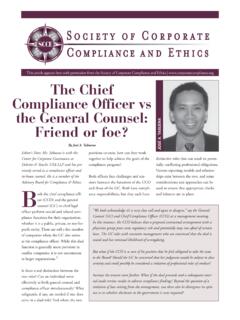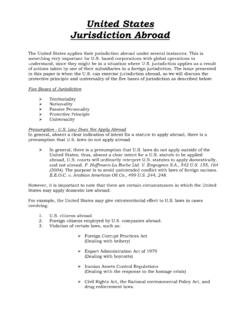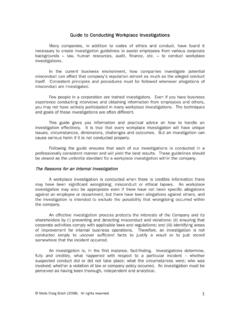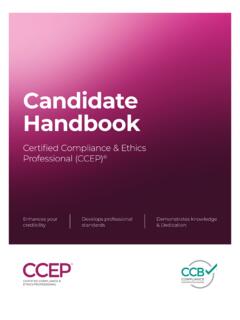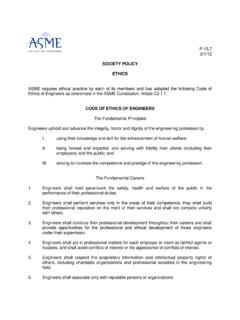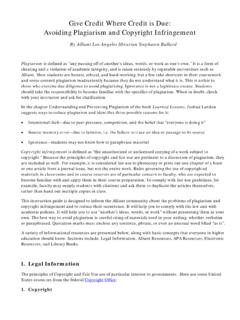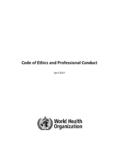Transcription of Intellectual Property and Compliance
1 Intellectual Property and Compliance Richard S. Gruner Professor of Law Director, Center for Intellectual Property Law John Marshall Law School Society of Corporate Compliance and ethics 6500 Barrie Road, Suite 250, Minneapolis, MN 55435, United States | +1 952 933 4977 or 888 277 4977. IP and Sarbanes-Oxley Compliance Sarbanes-Oxley requirements apply to asset control and monitoring systems IP assets are critical to many current business models Systematic means for protecting and monitoring IP assets are needed as part of overall Sarbanes-Oxley Compliance systems Executives and IP specialists must focus on IP.
2 Management systems to avoid loss of IP assets and reporting errors | +1 952 933 4977 or 888 277 4977 2. IP and Sarbanes-Oxley Compliance -- Topics Types of Intellectual Property (IP) to protect and monitor Sarbanes-Oxley requirements applicable to IP. management and valuation Components of IP asset control systems Risk assessments Essential system components Weak system indicators | +1 952 933 4977 or 888 277 4977 3. Types of Intellectual Property General Definition Intellectual Property includes Intellectual ideas and works that have replicable value Intellectual Property rights (IPR) exist independently of the products that depend on them Business value is frequently associated with IPR.
3 IP as business product ( movies). IP as basis for product ( Coca-Cola formula). IP as basis for service ( Google patents). IP as basis for making product ( manufacturing know how). | +1 952 933 4977 or 888 277 4977 4. Types of Intellectual Property Patents Typically cover new and useful processes, machines, articles of manufacture, compositions of matter, or any new and useful improvements of these items Require application to United States Patent and Trademark Office (USPTO). Drafting of applications is highly specialized Scope of resulting protection depends on both drafting scope and advocacy with examiners Examination may be lengthy and costly | +1 952 933 4977 or 888 277 4977 5.
4 Types of Intellectual Property Patent Enforcement Patent valid for 20 years from date of application Allows patent holder to prevent others from making, using, selling, or importing the patented invention and from aiding parties in these tasks Patent infringement damages can include treble damages for willful infringement Patent rights are transferable through assignments (transferring all rights) or licenses (transferring specific rights to do something otherwise prohibited). | +1 952 933 4977 or 888 277 4977 6. Types of Intellectual Property Copyrights Apply to original works of authorship including literary, dramatic, musical, artistic, and certain other Intellectual works, both published and unpublished Gained upon fixation of work in a tangible form from which it can be retrieved Recording of copyright with Copyright Office is not needed, but may aid enforcement Copyrights protect new expression but not ideas or reuse of old expression | +1 952 933 4977 or 888 277 4977 7.
5 Types of Intellectual Property Copyright Enforcement Copyright holders can prevent others from copying a protected work Copyright holders can also prevent parties from using the protected work in other valuable ways such as in public performances or in creating derivative works Fair use of protected works is allowed Usages with minimal impact on commercial value of the protected work Usages ( news reporting) in the public interest | +1 952 933 4977 or 888 277 4977 8. Types of Intellectual Property Trademarks A trademark is a word, name, symbol, or device that is used in trade with goods to indicate the source of the goods and to distinguish them from the goods of others Service marks are similar to trademarks but indicate the source of services Trade dress refers to the shape of product packaging ( the distinctive shape of a Coca- Cola bottle) and can be protected like trademarks | +1 952 933 4977 or 888 277 4977 9.
6 Types of Intellectual Property Trademark Enforcement A trademark must be registered and used in order to gain nationwide enforcement Local rights may be obtained through sustained use Trademark rights can be used to prevent others from using a confusingly similar mark to sell the same type of goods Trademark rights will not to prevent others from making or selling the same goods under a clearly different mark | +1 952 933 4977 or 888 277 4977 10. Types of Intellectual Property Trade Secrets A trade secret is any formula, pattern, device or compilation of information which is used in secret in a person's business, and which gives the person an advantage over competitors who do not know or use it Trade secrets are often lost due to: Failures to maintain reasonable physical secrecy Failures to restrict employee disclosures Independent rediscovery by others Disclosures upon product introduction | +1 952 933 4977 or 888 277 4977 11.
7 Types of Intellectual Property Trade Secret Enforcement Trade secret enforcement depends on state law Persons who have access to trade secrets in their work can be prevented from disclosing the trade secrets or using them for other businesses Persons who acquire trade secrets through wrongful means for example, by trespass or knowingly causing others to breach their obligations to keep trade secrets confidential . can also be precluded from using or disclosing the trade secrets | +1 952 933 4977 or 888 277 4977 12. Sarbanes-Oxley Requirements Related to IP. Public companies must disclose internal control systems for monitoring and valuing assets (Sarbanes-Oxley Act 404).
8 Asset control systems extend to Intellectual Property (IP) assets where material Asset acquisition and maintenance arrangements for IP assets are difficult due to intangible character Asset valuations for IP assets are complex and highly context-specific Reporting methods for IP controls are unclear | +1 952 933 4977 or 888 277 4977 13. Sarbanes-Oxley Requirements Related to IP (Cont.). Public companies must accurately disclose financial condition and business prospects (Sarbanes-Oxley Act 906). Valuation problems may carry over into financial reporting errors Positive statements about IP potential may overstate business prospects or understate known problems in perfecting or enforcing IP.
9 Rights Omissions about IP flaws or IP threats from competitors may undercut accuracy of business disclosures | +1 952 933 4977 or 888 277 4977 14. Sarbanes-Oxley Requirements Related to IP (Cont.). Corporate officers must certify accuracy of corporate disclosures (Sarbanes-Oxley Act 302, 906). Requirements extend to accuracy of both control system and financial condition disclosures Parties required to certify include CEO and CFO. Penalties for knowing miscertification include criminal sentences and substantial civil fines Threatened liability focuses strong attention by corporate officers on integrity and results of corporate asset control systems such as IP.
10 Control systems | +1 952 933 4977 or 888 277 4977 15. IP Asset Control Systems General Criteria Reasonable diligence Risk assessment as basis of design, implementation, evaluation and redesign Essential components Standard setting Training Monitoring Discipline and responses to system failures Typical indicators of weak systems | +1 952 933 4977 or 888 277 4977 16. IP Asset Control Systems Diligence An effective program will be reasonably designed, implemented, and enforced so that it generally will be effective in securing IP assets and reporting on them accurately Essential tasks Development and inventory of IP assets Valuation Accurate reporting | +1 952 933 4977 or 888 277 4977 17.


